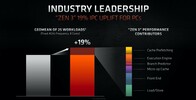Intel Core i5-13500HX vs AMD Ryzen 7 5800HS
Intel Core i5-13500HX
► remove from comparison
The Intel Core i5-13500HX is a fast mid-range mobile processor of the Raptor Lake series. Is was announced in early 2023 and integrates 6 fast Raptor Cove performance cores (P-cores) with HyperThreading and 8 Gracemont efficiency cores without Hyper-Threading. The P-Cores clock between 2.5 GHz (base) up to 4.7 GHz (single core boost, all-core 4.5 GHz). The smaller E-Cores clock between 1.8 and 3.5 GHz. All cores can access the combined 24 MB L3 cache.
Compared to Alder Lake, Raptor Lake offers improved P-Cores (Raptor Cove micro-architecture) with bigger Caches and more E-Cores (same Gracemont micro-architecture). Furthermore, the chip supports faster DDR5 memory (up to 5600 MHz for the 13980HX, but only 4800 MHz for the i5).
Performance
The average 13500HX in our database is in the same league as the Ryzen 7 7745HX, Core i7-13705H, Core i9-12900HK, Core i9-13900H, Core i9-13905H, as far as multi-thread benchmark scores are concerned. This is a very, very fast CPU, as of mid 2023.
Your mileage may vary depending on how competent the cooling solution of your laptop is and how high the CPU power limits are.
Power consumption
The chip's "minimum assured" power consumption sits at 45 W. Its maximum Intel-recommended Turbo power consumption is 157 W and the Base power consumption is supposed to be around 55 W. Most laptop makers will go for a value much higher than 55 W to get better performance.
The i5-13500HX is manufactured on Intel's 4th generation 10 nm process marketed as Intel 7 for average, as of early 2023, energy efficiency.
AMD Ryzen 7 5800HS
► remove from comparison
The AMD Ryzen 7 5800HS is a processor for big (gaming) laptops based on the Cezanne generation. The R7 5800H integrates all eight cores based on the Zen 3 microarchitecture. They are clocked at 2.8 (guaranteed base clock) to 4.4 GHz (Turbo) and support SMT for a total of 16 threads. The chip is manufactured on the modern 7 nm TSMC process. Compared to the 5800H (up to 54 W), the 5800HS is configured to a TDP of 35W.
The new Zen 3 microarchitecture offers a significantly higher IPC (instructions per clock) compared to Zen 2. For desktop processors AMD claims 19 percent on average and in applications reviews showed around 12% gains at the same clock speed.
In addition to the eight CPU cores, the APU also integrates a Radeon RX Vega 8 integrated graphics adapter with 8 CUs (512 shaders) at up to 2,000 MHz. The dual channel memory controller supports dual-channel DDR4-3200 and quad-channel LPDDR4-4266 energy efficient RAM. Furthermore, 16 MB level 3 cache (up from 8 MB at the 4800U) can be found on the chip.
Performance
While we have not tested a single system built around the 5800HS as of August 2023, we have tested several laptops featuring the 5800H, a chip with very similar specs (Cezanne, 8 cores, 16 threads, up to 4.4 GHz). Based on that, we fully expect the 5800HS to be just slightly slower than the Core i5-12500H, Core i7-11800H, Core i7-12650H, Core i9-11950H and also the AMD Ryzen 9 4900H, as far as multi-thread benchmark scores are concerned. Which is pretty damn fast, as of late 2022.
Your mileage may vary depending on how competent the cooling solution of your system is, and how high the CPU power limits are.
Power consumption
The Ryzen has a default TDP, also known as the long-term power limit, of 35 W. A proper cooling solution is a must for a CPU like this.
This Zen 2-based APU is built with TSMC's 7 nm process for average, as of mid 2023, energy efficiency.
| Model | Intel Core i5-13500HX | AMD Ryzen 7 5800HS | ||||||||||||||||||||||||||||||||||||||||||||||||||||
| Codename | Raptor Lake-HX | Cezanne-HS (Zen 3) | ||||||||||||||||||||||||||||||||||||||||||||||||||||
| Series | Intel Raptor Lake-HX | AMD Cezanne (Zen 3, Ryzen 5000) | ||||||||||||||||||||||||||||||||||||||||||||||||||||
| Series: Cezanne (Zen 3, Ryzen 5000) Cezanne-HS (Zen 3) |
|
| ||||||||||||||||||||||||||||||||||||||||||||||||||||
| Clock | 1800 - 4700 MHz | 2800 - 4400 MHz | ||||||||||||||||||||||||||||||||||||||||||||||||||||
| L3 Cache | 24 MB | 16 MB | ||||||||||||||||||||||||||||||||||||||||||||||||||||
| Cores / Threads | 14 / 20 6 x 4.7 GHz Intel Raptor Cove P-Core 8 x 3.5 GHz Intel Gracemont E-Core | 8 / 16 | ||||||||||||||||||||||||||||||||||||||||||||||||||||
| TDP | 55 Watt | 35 Watt | ||||||||||||||||||||||||||||||||||||||||||||||||||||
| Technology | 10 nm | 7 nm | ||||||||||||||||||||||||||||||||||||||||||||||||||||
| Die Size | 257 mm2 | |||||||||||||||||||||||||||||||||||||||||||||||||||||
| max. Temp. | 100 °C | 105 °C | ||||||||||||||||||||||||||||||||||||||||||||||||||||
| Socket | BGA1964 | FP6 | ||||||||||||||||||||||||||||||||||||||||||||||||||||
| Features | DDR4-3200/DDR5-4800 RAM, PCIe 5, Thr. Director, DL Boost, GNA, MMX, SSE, SSE2, SSE3, SSSE3, SSE4.1, SSE4.2, AVX, AVX2, BMI2, ABM, FMA, ADX, VMX, SMEP, SMAP, EIST, TM1, TM2, HT, Turbo, SST, AES-NI, RDRAND, RDSEED, SHA | DDR4-3200/LPDDR4-4266 RAM, PCIe 3, MMX, SSE, SSE2, SSE3, SSSE3, SSE4A, SSE4.1, SSE4.2, AVX, AVX2, BMI2, ABM, FMA, ADX, SMEP, SMAP, SMT, CPB, AES-NI, RDRAND, RDSEED, SHA, SME | ||||||||||||||||||||||||||||||||||||||||||||||||||||
| iGPU | Intel UHD Graphics Xe 16EUs (Tiger Lake-H) ( - 1500 MHz) | AMD Radeon RX Vega 8 (Ryzen 4000/5000) ( - 2000 MHz) | ||||||||||||||||||||||||||||||||||||||||||||||||||||
| Architecture | x86 | x86 | ||||||||||||||||||||||||||||||||||||||||||||||||||||
| Announced | ||||||||||||||||||||||||||||||||||||||||||||||||||||||
| Manufacturer | ark.intel.com | www.amd.com | ||||||||||||||||||||||||||||||||||||||||||||||||||||
| L1 Cache | 512 KB | |||||||||||||||||||||||||||||||||||||||||||||||||||||
| L2 Cache | 4 MB |
Benchmarks
Average Benchmarks Intel Core i5-13500HX → 100% n=2
Average Benchmarks AMD Ryzen 7 5800HS → 67% n=2
* Smaller numbers mean a higher performance
1 This benchmark is not used for the average calculation













